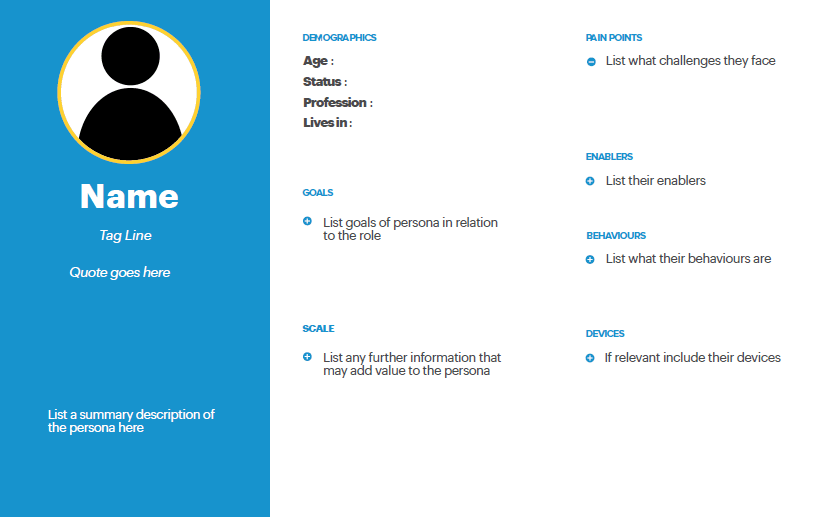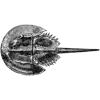Topics
- Discover/Search stage of the UX process ( The importance of user research )
- Define/Describe stage of the UX process ( Goals and ideas )
1. The importance of user research (Discover stage of the UX process)
This explained the research phase, and should give you an idea about what you want your product or website to do.
We're going to look at:
- Why it is important to interact with your users during the design process, different ways of doing it,
- How to represent different user groups with personas.
The key topics we're going to cover are (the research phase)
- Importance of user feedback
- User research methods
- Creating personas
1. Importance of user feedback
The first step in the discover phase is to understand who your users are going to be.
It is a common trap to design for yourself, which may work well if the user is similar to you, but it is more likely to miss out on a huge portion of needs or fail to address problems that you haven't seen because you are too close to the issue.
So research to try and find out what needs you are filling for them, what are their pain points right now? Are they familiar or brand new to the concept? Have they tried this technology before? What age, nationality, hobbies, or activities do they have?
Remember, your users may vary. So try to understand any commonalities or differences that they may have, so that you can cater for them.
Input from representatives of real users is by far the easiest and safest way to ensure that, before you build anything, you're are on the right track.
2. User research methods
Now, let's move on to user research methods. There are many ways you can learn about your users.
First, try to decide what's important, and then choose which approach is best.
- Interviews or focus groups with typical users are a great way to start.
- Interviews with typical users are a great way to start to learn about your users. It is important to write an Interview question guide, so you know what questions to ask and what information you want to gather.
- Also, this can be with a variety of members of the public, staff from a company, or even your friends. It completely depends on your project.
- Surveys and questionnaires about what they do right now and how they feel about it.
- Surveys and questionnaires are also good ways to gather data about what they do right now, what their goals are and how they feel about it. Try and ask open ended questions!
- Market research, using reports and statistics or anything else that is available.
- You can also use focus groups, stakeholder insight and competitor market research, using reports and statistics or anything else that is available as well. Once you gather data to analyze, it is important to identify patterns and see if they overlap and emerge naturally.
- Watching them use existing sites or a competitor’s mobile apps can also give you a lot of information.
- Often what people say they do and what they actually do are very different.
- Formal lab-based usability studies can track people's eye gaze and emotions as they interact if you need some serious numerical data.
- Remember not to try and lead the user into answers with your questions.
- Try and stay away from things like, wouldn't it be great if the product did this?
- And go more towards questions that don't lead them anywhere, such as, what are your frustrations? What would you like the product to do?
3. Creating personas
What is the purpose of a persona?
To understand a profile of a typical user, their motivations and experience, and to help create your design. Making a persona gives you the profile of a typical user that will help you make decisions about the design of your product.
You can't have all of your users give input, especially if you're marketing to a huge audience base. But there are ways of describing different types of user, so you can make sure your design works for them. These are called personas.
Essentially, they're a profile of an example user, a story about who they are, what motivates them, what brands they like or preferences they have, what are their pain points, or any other information to help you characterize them.
Now, you can have anywhere between one to a dozen personas, depending on your project. But the more flavor and life you give to your personas, the more you can tailor your design to them.
So let's talk about some example personas:
Imagine you're selling mobile phone handsets. There are things that you would want to discover about your different types of users. Giving your persona a name and a photo can help bring them to life. Take Mohammed, for example. Mohammed is 25, and he's a fashion phone upgrader. He has to have the latest phone on the market, and he loves showing it off to his friends. For Mohammed, a year is too long to have a phone. Now, you should understand your personas' points of views and attitudes. And you should also have some kind of back story as to how they use existing products or services.
Characteristics and demographics are also important, along with capturing your users' key goals, such as having the latest phone on the market. Try and also defined some measures that you can mark on a scale, such as how cost sensitive they are.
These can be handy to check your design against and make sure you're still fulfilling the needs.
If you do have less time to research, it is still worth having a high level summary of different types of users.
Mobile phones, for example, you may want to break into business, casual, and devoted users, who all have very different characteristics and motivations. And although this example is far less detailed than the previous one, personas are still useful.
HERE'S we have to add persona example in this persona template:

-Resource: Creating Personas
2. Goals and ideas (Describe stage of the UX process)
This explains the next phase, ‘describe’, where you can start to find your solution by brainstorming with an open mind whilst clarifying your main goals and requirements.
We're going to look at how to go about beginning to scope out your solution by brainstorming with an open mind and whilst also clarifying your main goals and requirements.
First, let's define your goals. And we're looking specifically at the describe phase of the UX process.
You probably have a broad idea of what you want your product or website to do or what problem you want it to solve. And with the user research you've now gathered, you should be able to define a little more clearly what it needs to do.
Think about what specific goals the user might have, what the outcome should be or any other information or key points that you might find useful. Try and frame the questions to yourself such as:
- What will the user have achieved if they're successful?
- How should they feel during it.
- If they can't meet their main goal, such as finding a product on a shopping site, how will they feel supported?
- Now think back to your original concept, does it still hold true?
- Do you need to tweak or clarify it, or have you discovered a different problem or a better opportunity entirely?
Say, for example, your goal is to have the latest sports trainers available.
Now comes the fun bit which is Brainstorming. "Brainstorming" is about casting the net wide, thinking up lots of different possibilities without going into too much detail on each one. Don't analyze or criticize at this stage. Throw about different ideas and concepts without judging them. You can work on the details later.
But the important part of this phase is to be open and think as broadly as you can about which different possibilities might meet all or part of your goals and please the personas that you've created.
You might find it useful to use a whiteboard, big sheets of paper, post-it notes, or even have a search engine open, anything that helps you be creative.
A technique called "Mind mapping" involves jotting down one idea and then another that is either related or builds on it and seeing where it goes.
So "Mind mapping" is a visual tool for related ideas and terms enhancing the brainstorming process. In essence, you’re drawing a picture of the relationships among and between ideas.
Start by writing down your goal or challenge, and branch off correlating words, ideas or concepts. This helps you develop a well-rounded view on a single or multiple idea.
You can use mind mapping software or simply sketch it on paper or a whiteboard.
So let's think back to our example of having the latest sports trainers.
Some of the brainstorm ideas you might come up with may be a virtual reality tour of high street shops, a footballer fashion show, a website showing galleries of different sports trainers, or even a sports highlight reel with closeups of sport shoes.
And finally, let's define your requirements. From here, it's time to narrow in a little, be a bit more specific. From all your goals and ideas you've come up with, what is really important? Try and list out the things that are absolutely critical for your solution to do. In other words, without them, there really is no point.
Then there's other things that it should really do to provide a great experience. And finally, things that might be nice to have but are not essential and don't matter to the customer.
Now this prioritized list of requirements will help you to check back against your brainstorm ideas and see which ones might work best to fulfil them. And because this specific list is linked to your goals, these ideas are the ones that can become reality. Some of your ideas may have been fun but not work in the real world.
Take the virtual reality tours, for example, it still meets the requirements, but may not be feasible within your current budget.
Others may have some good parts, such as the footballer fashion show, which is a nice addition, but doesn't meet requirements.
Your final result will often consist of a mix of the good parts from all the ideas you have come up with. You just need to find a balance between what is feasible and what's within your needs.
Brainstorming sessions work best when you generate lots of ideas rather than making sure that they’re neatly documented. Brainstorming is an excellent way to generate ideas quickly and without judgement, and they will help you to imagine your concept.
It doesn’t matter how you capture the ideas, as long as you don’t lose them. It’s important not to judge ideas during the brainstorming session as some of them may be useful later on during design or may get adapted as you clarify your concept.
So to summarize, You need to :
- Define your goals
- Brainstorm ideas
- Define your requirements.
But often that stroke of genius that will make you successful comes from turning off the judgement for a while and letting the creative juices flow.
For me as a user, The main customer goal I have when buying sports is to be suitable for the sport I am intending to use them (ie. mountain climbing, football, tennis...). Also usability/quality/durability. Other goals include: look/aesthetic, comfort, agile, light and cost. I want the product to last and withstand the usage they are going to be put through so I can concentrate on the sport or activity and perform at my best. Something I have found really useful on a couple sports wear/equipment websites I have been on is the ability to compare different products.
Resource: Read more about brainstorming







Top comments (0)